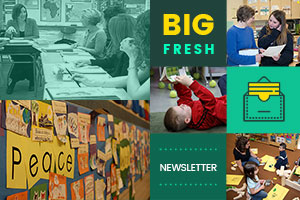The first duty of a revolutionary is to get away with it.
Abbie Hoffman
Earlier this month I visited Franki Sibberson’s fifth-grade classroom in Dublin, Ohio. She began a writing minilesson with a confession. “Many of you know I write a blog with Ms. Hahn. Well, I haven’t contributed much of anything in a couple of months. So I need to write more. I looked over some of my previous posts to see what was going on with my leads to help me get started.”
She then brought up a few of her blog posts at A Year of Reading (the blog Franki shares with Mary Lee Hahn) on a projector for the class. She read the first sentences of the lead in each one. “They all sound the same.” Long pause. “Pretty bad, right?” She nodded at the students, encouraging them to agree with her negative assessment of her writing. “I decided to look at the leads of some of my favorite blog writers to get inspiration for new ways to write leads.” She then scrolled down to three leads on entries from other blogs.
Franki highlighted what made these leads from other writers engaging, and then quickly tried an “If/Then” and a humorous strategy for reworking her leads that she borrowed from them. She gave students a moment to respond with how they might try to look for mentor leads from authors they admired, and how the strategy of mimicking writers they admired could also work for writing conclusions.
It was less than seven minutes from the start of the minilesson till students were off the rug and moving to write on their own. I was left wondering how a textbook minilesson structure with a quick intro, mentor texts, and a teacher using her own writing to make a point could be so wildly subversive. Here’s what Franki did that I rarely see in classrooms:
1. Acknowledge that failure is an ongoing part of developing writing habits and skills.
Franki was matter-of-fact in admitting she hadn’t been writing as much for the blog as she needs to. No recriminations or story of how she triumphed, just the expectation that her ten- and eleven-year-old students are sophisticated enough to understand the slog of a writing life with its ups and downs, fits and starts.
2. Build on the first presentation of failure with . . . more failure.
Franki not only hasn’t been writing much — she showed her students numerous examples of how she was writing poorly, or at least not making enough of an effort to craft engaging leads.
“Pretty bad, right?” The expert on writing in the front of the room has some first-draft writing floating around on her blog, and becoming a better writer begins with acknowledging there is room for improvement.
3. Play with writing that will never be published anywhere, just to have fun with testing out different techniques.
Watching Franki quickly try out a couple new strategies for leads, I was reminded of how often I had to practice scales and long tones when I was learning to play the clarinet. It’s time spent honing skills through close attention and repetition. Understanding of technique builds through mimicking and riffing off the possibilities. Sometimes it’s fun, sometimes it’s dreary, but it’s what you do to learn and improve in any art form.
Lessons like Franki’s look effortless. She speaks naturally with her students as fellow travelers on the never-ending journey of learning to write well. A willingness to share the failure, messiness, and endless improvisation that defines a lifetime of writing takes a lot of trust on the part of teachers and students. It’s not the natural order of things in classrooms — we are accustomed to the teacher always being the expert. What’s normal is to break each component of the writing life up into clear and artificial little subsets, with points for demonstrating “mastery” of each one of them. That’s not how it works in reality, and our students deserve the truth. It’s right in front of us in our own experience, if we have the courage to share it with them.
This week we look at building background knowledge with students. Plus more as always — enjoy!
Brenda Power
Founder, Choice Literacy
Free for All
[For sneak peeks at our upcoming features, quotes and extra links, follow Choice Literacy on Twitter: @ChoiceLiteracy or Facebook: http://www.facebook.com/ChoiceLiteracy or Pinterest: http://pinterest.com/choiceliteracy/]
Mark Levine finds his middle school students are appalled by some of the cultural differences from times gone by, and shares how he fosters more understanding:
http://www.choiceliteracy.com/articles-detail-view.php?id=2588
Karen Terlecky writes about the importance of building background knowledge before more complex read alouds. She uses a paired text approach:
http://www.choiceliteracy.com/articles-detail-view.php?id=1816
Beth Moore considers what teachers need to know and think about when student writing makes them uncomfortable:
http://twowritingteachers.org/2018/05/10/uncomfortable-topic-choices/
For Members Only
Melanie Meehan considers content and context for students who struggle to master new skills because of a lack of background knowledge:
http://www.choiceliteracy.com/articles-detail-view.php?id=2936
Tara Smith finds her sixth graders love historical fiction, but they often lack the background knowledge to understand texts fully. She launches her historical fiction unit with a careful mix of discussion, anchor charts, and shared texts:
http://www.choiceliteracy.com/articles-detail-view.php?id=2932
In this week’s video, Aimee Buckner has a quick conference with a fourth grader about ways to solve a dilemma — how to figure out the setting in a historical fiction novel when there are no pictures:
http://www.choiceliteracy.com/articles-detail-view.php?id=1696
Curious to see Franki Sibberson’s minilesson on leads described at the start of the newsletter? We’ve included it as a bonus video:
http://www.choiceliteracy.com/articles-detail-view.php?id=2969
You can explore more ideas for building background knowledge in the content literacy section of the website:
http://www.choiceliteracy.com/articles-popular-category.php?id=10019
That’s all for this week!



